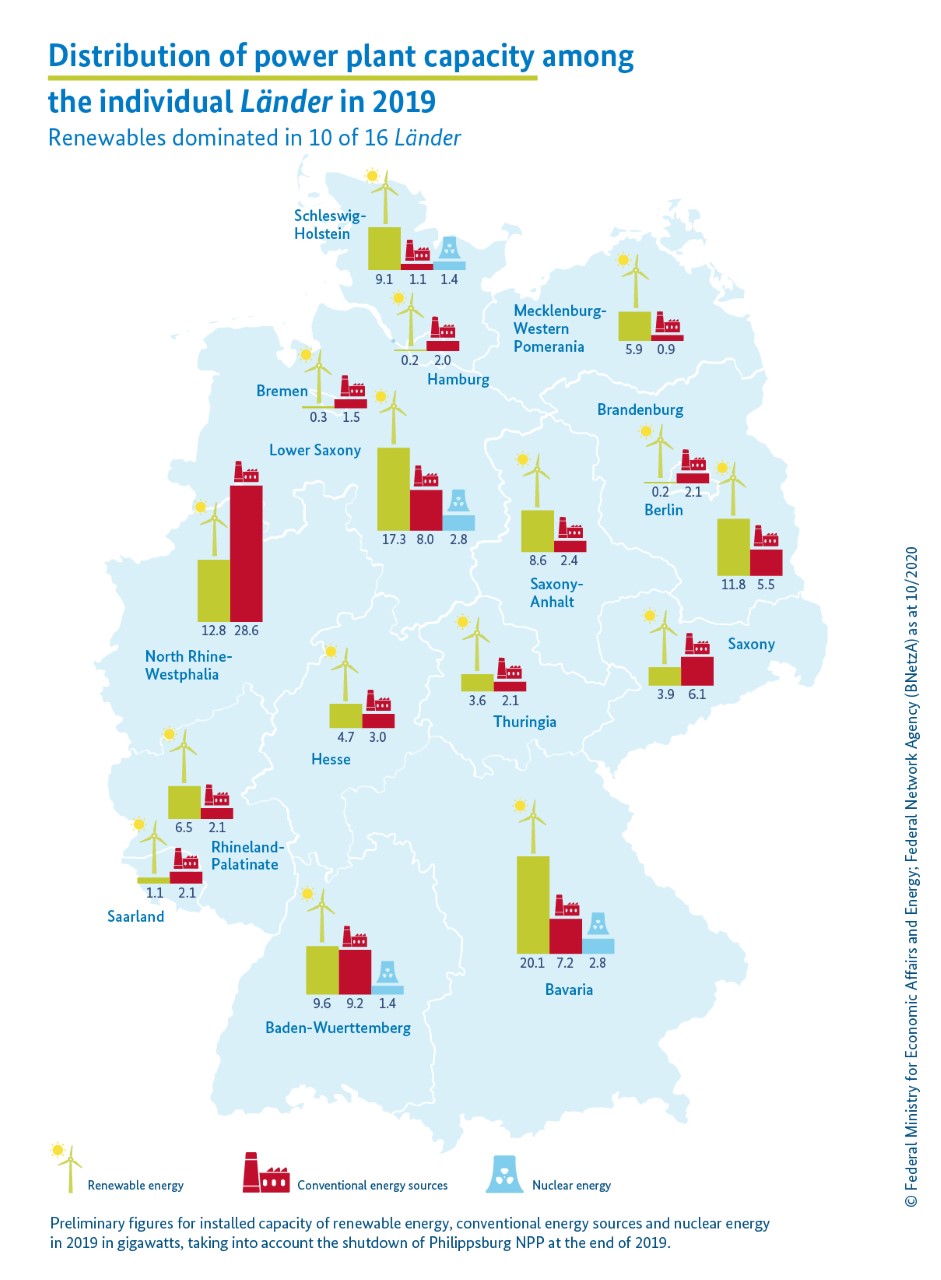More and more power plant capacity based on renewables
In Mecklenburg-Western Pomerania, Schleswig-Holstein, Saxony-Anhalt and Rhineland-Palatinate, renewable energy accounts for the highest share of total installed power plant capacity. In North Rhine-Westphalia, conventional power plants still predominate by a sizable margin.
 © Federal Ministry for Economic Affairs and Energy; Federal Network Agency (BNetzA) as at 10/2020
© Federal Ministry for Economic Affairs and Energy; Federal Network Agency (BNetzA) as at 10/2020
In Germany, renewable energy is continuing to gather strength. A quick look at the 2019 figures for installed power plant capacity across the German Länder (federal states) reveals that renewable energy was already dominant in ten of all 16. However, considerable differences exist between the individual Länder. At the end of 2019, the highest installed power plant capacity based on renewable energy was found in Bavaria, with 20.1 gigawatts (GW). Solar plants accounted for more than 65% of this figure. Lower Saxony had the second highest installed renewable power plant capacity, at 17.3 GW. Unlike in Bavaria, onshore wind turbines accounted for about 65% of the installed capacity of renewables in this Land. In contrast, North Rhine-Westphalia, which has a lignite mining region and former hard coal mining industry, was the front-runner in conventional power plants, which provided 28.6 GW of power plant capacity. Some 12.8 GW were, however, provided by renewables here as well.
In terms of total installed capacity per federal state, Mecklenburg-Western Pomerania (87%), Schleswig-Holstein (78%) and Saxony-Anhalt (78%) had the highest share of renewables. Mecklenburg-Western Pomerania had 5.9 GW of power installed plant capacity based on renewables, whereas conventional power plants only accounted for 0.9 GW. At the end of 2019, Schleswig-Holstein had 9.1 GW of installed renewable capacity. Conventional energy sources made up just 1.1 GW. In Saxony-Anhalt, 8.6 GW was available from renewables, while fossil energy sources made up 2.4 GW.
'Installed power plant capacity' indicates the maximum possible electricity that a generation plant can produce. This value is however normally higher than actual generation. This is because wind turbines and photovoltaic plants do not always produce at full load as wind and solar energy are intermittent, and conventional power plants have to undergo maintenance and their electricity generation is confined for flexibility reasons. The installed capacity especially of different renewables but also of renewables with conventional energy sources is therefore only comparable to a limited extent.
Nuclear energy: last nuclear power plants to go off-grid by the end of 2022
Schleswig-Holstein is one of a total of four federal states in which nuclear power is still used in electricity generation. In 2019, 1.4 GW was available here from nuclear power; in Lower Saxony and Bavaria, the figure was 2.8 GW. In Baden-Württemberg, one reactor producing 1.4 GW was still in operation after the shutdown of the Philippsburg nuclear power plant at the end of 2019. By the end of 2022, the bar for nuclear power in statistics graphs will drop to zero when the last German nuclear power plants are taken off the grid and their operating licences expire. After the nuclear disaster in Fukushima in 2011, the Federal Government did some work on its energy concept and accelerated the phase-out of nuclear power. Since then, eleven nuclear power plants have been gradually taken off the grid. The remaining nuclear power plants are still allowed to generate precisely defined amounts of electricity under the control of the Bundesnetzagentur (Federal Network Agency) until they are decommissioned (For more information about the phase-out of nuclear power, please click here).
Coal phase-out: compensation for hard coal-fired power plants ensures successful first round of auctions
Like the use of nuclear, the share of fossil fuels will also continue to decline. This is because ending coal-fired power generation (in German only) in Germany is already a done deal. Germany wants to phase out coal by 2038 at the latest and is following the recommendations of the Commission for Growth, Structural Change and Employment (KWSB) (in German only). At the end of November 2020, the European Commission established key foundations for this process by approving a compensation programme for hard coal-fired power plants. This enabled the scheduled closure of four gigawatts of coal-fired power plant capacity (in German only) to take place before the end of 2020.
Further information
- Press release by the Federal Ministry for Economic Affairs and Energy: 'Minister Altmaier: "First coal-fired power plants to be taken off the grid this year as planned" '. (in German only)
- Article by the Federal Ministry for Economic Affairs and Energy: 'Coal phase-out and structural change' (in German only)
- Federal Network Agency: 'Results of first tendering process to reduce the production of electricity from coal'

